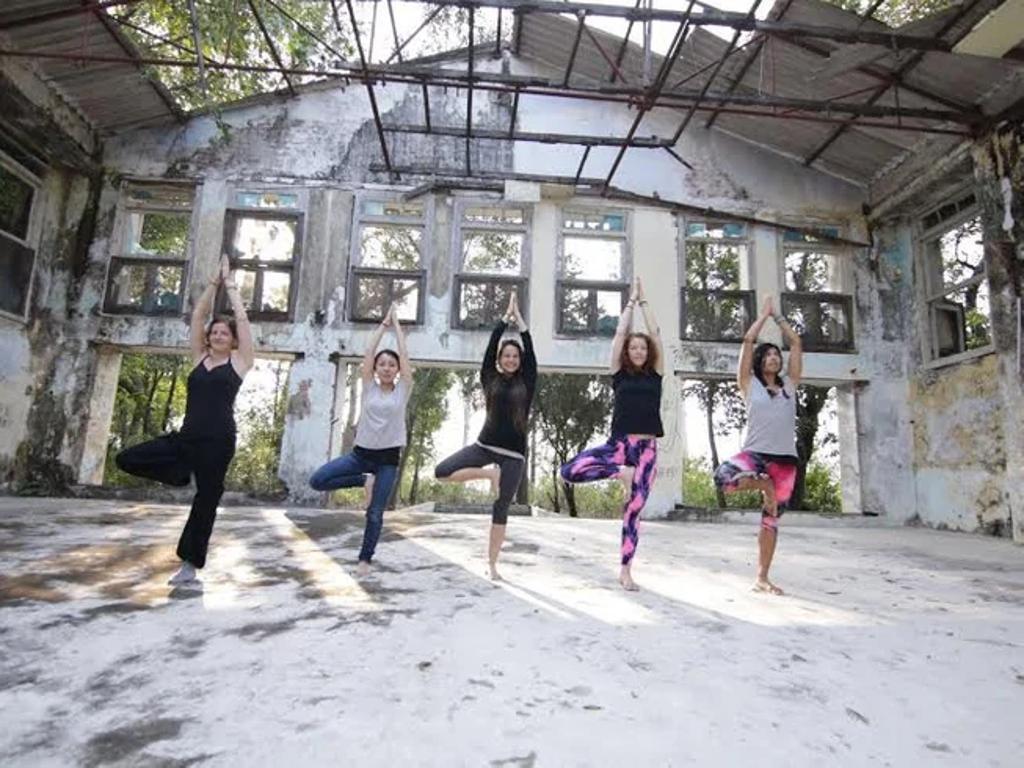The Art of Teaching Yoga with Book Yoga Life Retreats Teacher Training Program
So, you have reached that crossroad in life where you know yoga will be a big part of your life going forward. There are a million and one questions on how to go forward. Rest easy as we have asked our yogis to compile a guide on what to consider, how and where to start and what should you be thinking about regarding employment opportunities!
According to our yogi participants the usual big questions are; where do I start? What is the best way forward? Where should I study? What style is best for me? What is the most in demand style to teach as a professional yoga instructor? Where can I teach?
Becoming a yoga teacher instructor is a fulfilling journey, but it requires careful consideration and planning. The most fundamental considerations are: choosing the right yoga style, selecting the certification that is most effective and ultimately selecting the best location for training and potential employment opportunities.
Our yogis’ insights have been summarised in this guide so our tribe of aspiring yogis have a starting point that will help them make informed decisions about their amazing journey ahead!
The Yoga Philosophy:
Selecting the appropriate yoga style is crucial as it determines the approach, philosophy, and techniques you'll be teaching. The most popular styles include Hatha, Vinyasa, Ashtanga, Bikram, Kundalini, Yin yoga, but keep in mind that there are numerous “niche” styles.
Take some classes of each yoga style and explore their individual style as they all have their unique philosophy and focus that often cater to different preferences and objectives.
Your inspiration and connection with your chosen yoga style is a major factor to consider as it will impact you and your potential students so taking the time to choose carefully is key!
For example, Hatha yoga emphasizes physical postures (asanas) and breath control (pranayama), making it suitable for beginners and is arguably the most popular style globally.
Ashtanga yoga follows a structured sequence of poses, offering a rigorous and disciplined practice and is also a very popular style. Vinyasa yoga synchronizes breath with movement, creating a flowing and dynamic experience and is also taught expensively globally.
So, when choosing a yoga style, consider your personal preferences, teaching goals, and the target audience you wish to reach.
Registration & Certifications
In general, a yoga teacher training course such as a’ yoga teaching training program (YTT) or a 500-hour 200 hours yoga instructor course will provide you with the school’s certificate of completion essentially qualifying you as a yoga instructor. Some schools are very well respected while others are unknown beyond their local area and thus an international employer will prefer to hire someone with a reputable certificate. That’s where the various yoga “organizations” come into it!
The major players are
1. Yoga Alliance (YA)
The most popular yoga registration organisation with the most members across the industry. Often considered the industry standard they offer the most widely accepted 200-hour yoga alliance certified teacher training certificate. They also offer 300-hour and 500 hours yoga teacher training certificates.
2. International Association of Yoga Therapists (IAYT)
This organization offers a rigorous and comprehensive training program that is often part of yoga therapists course.
3. American Council on Exercise (ACE)
ACE is a well-respected council (not a yoga organisation) mainly focused on the fitness industry but provides a comprehensive understanding of yoga related exercises.
4. Yoga International (YI)
We pay for the things we value most.This organization offers a comprehensive and respected yoga teacher training program that covers most critical elements of yoga practice and teaching.
5. British Wheel of Yoga (BIY)
The British Wheel of Yoga offers a range of yoga teacher training courses and is a well-regarded organization in the yoga community.
Organisations such as yoga alliance offer schools the option to register their yoga instructor program with them.
For example, a host in Rishikesh India can have their 200 hour yoga teacher program and 500 hour yoga teacher training course registered with yoga alliance. Graduating from these gives you a RYT a registered yoga teacher certificate . Usually a 200-hour Registered Yoga Teacher is abbreviated as 200 RYT and the 500 hour registered yoga teacher certificate as 500 RYT and so on. The 500 indicates the number of training hours completed.
The 500 indicates the number of training hours completed. The registration attainment is an assurance that a participant has achieved the yoga alliance standard and is registered with that yoga organization. While a 200-hour certification is sufficient to start teaching, a 500-hour certification provides deeper knowledge and expertise.
In summary, can you teach yoga without a registered certificate - sure you can, but, will you have more employment opportunities with a reputable organization such as a Yoga Alliance Certified Teacher Training Course or that offers a registered certificate? Undoubtably YES! So, obtaining a highly regarded certification is important especially when it comes to establishing your initial credibility as an instructor.
The teacher training program
Choose a program such as the 200-hour Yoga Teacher Training course or the 500-hour Yoga Teacher Training course that adhere to a high standard in terms of curriculum as in the long run what you learn here will most likely become the foundation of your practise.
The curriculum should encompass, yoga philosophy, postures, essential yoga texts and history, traditional practices, anatomy, and effective teaching methodologies.
Take the time to vet quality through reviews, testimonials, and overall school accreditation. Lastly, prioritize programs led by experienced instructors passionate about fostering growth and imparting knowledge to ensure a transformative experience.
Where should I train?
The world is your oyster, and you are spoilt for choice. Too often the problem with a yoga retreat is there are too many good choices! Cost is an important factor, so where you live and where you have to travel to is always a critical factor – but excluding flight tickets the general consensus are:
Asia
India is the heart of yoga! 200 hour yoga teacher training Rishikesh is probably the most popular course while 500 RYT Goa is also popular among aspiring yoga instructors.
India is where the ancient practice spawned and today there are a plethora of ashrams, schools, and retreat centres. A close second, when it comes to the number of options, is Indonesia with the 200 hour yoga teaching training Bali programs in amazing locations such as Ubud offering most yogis the opportunity to combine a yoga retreat with a plethora of additional travel experiences.
Europe
In Europe, 200 hour yoga teacher training Spain emerges as a prominent option for yoga teacher training, particularly in regions like Andalusia and Catalonia. Picture-perfect settings amidst ancient olive groves or tranquil seaside villages provide an immersive learning experience steeped in Spanish culture.
The 500 RYT Portugal also offers a cost effective option in this location as well. Alternatively, in more recent times the 200 hours yoga instructor course Greece programs have increased in popularity as they offer high quality instructors that are affordable and ultimately yogis can combine them with the awesome additional activities that Greece has to offer.
Latin America
200 hour yoga teacher training Costa Rica is fast becoming one of the most searched YTT on our site. Costa Rica is a haven for nature lovers and spiritual seekers, that boasts breathtaking natural landscapes and eco-friendly retreat centres that are simply amazing.
Our yogi’s favourite program in Latin America is the 500 hour RYT Peru as you can explore the majestic peaks of the Andes and sacred sites like Machu Picchu while delving into yoga philosophy and practice in serene mountain retreats.
When evaluating countries for yoga teacher training, consider factors such as the cost of living, visa requirements, cultural compatibility, language barriers, and the reputation of training centres. Think carefully and deeply as you must balance the too often short-term costs versus the long term benefits – not an easy thing to do, we know!
Employment considerations
When considering where to work there are so many factors to consider so asking our yogis for the top 3 considerations they have picked, work availability, visa requirement and currency. While work availability is an easy one – its worth considering that some visa requirements can be quite complex and expensive, so take the time to research these.
Currency, you may get paid well by local standards but if you repatriate you need to consider what your actual earnings are worth in your base country of residence.
In Europe, Spanish cities like Barcelona and Madrid offer thriving yoga scenes with numerous studios and wellness centers, alongside coastal regions like Ibiza and the Canary Islands, which attract tourists for retreats, creating seasonal employment opportunities.
EU citizens may find relatively straightforward visa requirements, but non-EU citizens may encounter more bureaucracy. Spain also offers attractive incentives for digital nomads, including visa programs and tax breaks, making it an appealing destination for remote workers including yoga instructors.
In Asia, Bali, is a mecca for yoga retreats and teaching opportunities abound in studios, retreat centers, and resorts amidst lush landscapes. Visa requirements are typically straightforward, especially with visa-on-arrival and extension options.
Bali's favourable tax regime includes a low personal income tax rate and incentives for foreign-owned businesses, offering potential tax advantages for yoga instructors establishing themselves in the region.
Additionally, Bali has recently introduced digital nomad visa programs, providing long-term stays for remote workers, including yoga teachers, who can take advantage of the island's affordability and vibrant community of expats and entrepreneurs.
India, particularly in cities like Rishikesh and Goa, provides employment opportunities in ashrams, yoga schools, and wellness resorts catering to both locals and international visitors. Visa requirements vary, with some countries eligible for e-visas or visa-on-arrival facilities.
While navigating India's bureaucratic processes can be challenging, the country offers tax benefits for foreign residents, including exemptions on income earned outside India and reduced tax rates for certain types of income, potentially easing the tax burden for yoga teachers working in the country.
Here are some of our Yogis recommendations across the world.
Asia
Rishikesh: 200 Hour Yoga Teacher Training Rishikesh
Europe
Latin America
Costa Rica: Immersive Jungle Yoga Teacher Training in Costa Rica
There you have it, “a guide to becoming a yoga instructor”. You are on an amazing journey that will transform not only your life but the lives of so many others that you will meet and train. Our yogis tell us their choice to become a registered yoga instructor as changed their lives forever. We wish you a similar transformation and want to hear from you so join our community on www.bookyogaliferetreats.com or our social page on Facebook and Twitter and tell us about your journey!
Love
Book Yoga Life Retreats










